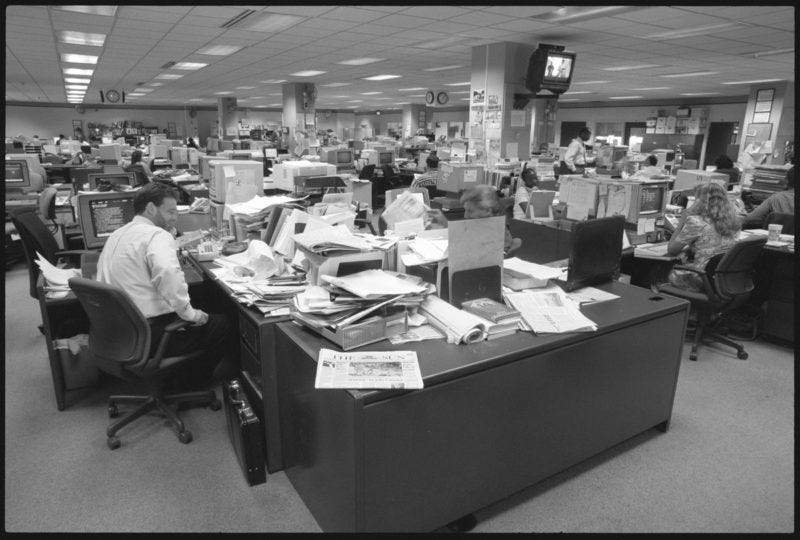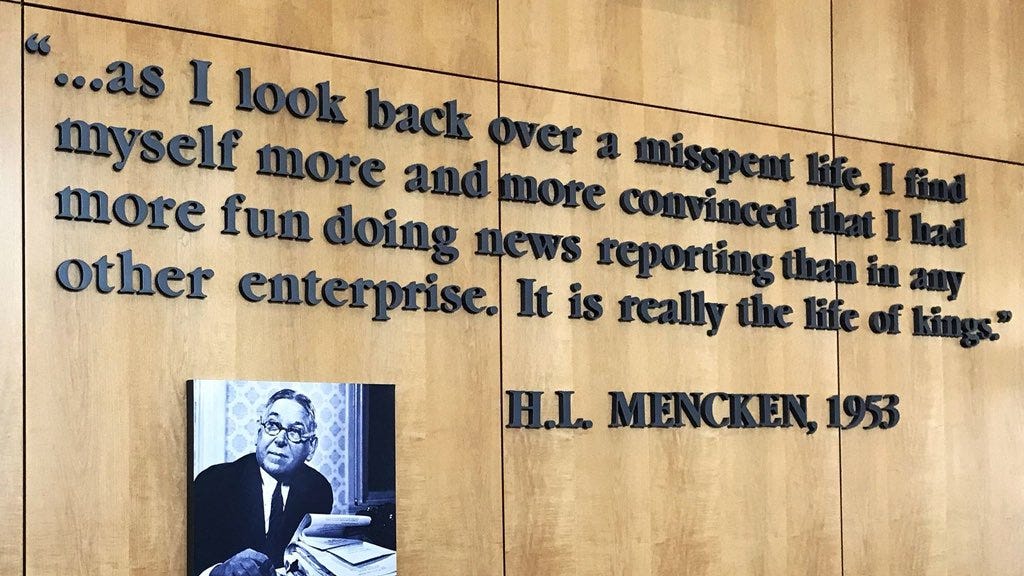BALTIMORE OBSERVED: Newspaper Dreams
It really does go by in the wink of a young girl's eye. I finally get up the nerve to call Michael Olesker, and suddenly, I'm there again: College Park, Maryland, Summer of '83.

Ink stains my hands and my shirt, some days even my face. There’s a cigarette in my mouth, a 20-ounce 7-Eleven coffee in my left hand, my daily fix of newspapers under my right arm: The Baltimore Sun, The Evening Sun, The Baltimore News-American, The New York Times, The Washington Post, The Philadelphia Inquirer.
Back in the Summer of ‘83, in College Park, I’m in love for the first time — convinced She’s the One — and I cannot recall ever being happier in my life.
Since delivering The Morning Sun as a kid — a paper then owned by the A.S. Abell Co. — I never dreamed of being anything other than a newspaperman.
Now I’m editor in chief of the University of Maryland’s independent student daily newspaper, The Diamondback.
A little bit of heaven here on Earth.
When I get back to the Diamondback newsroom, atop the South Campus Dining Hall, and deep into the night, I’ll read all those papers, but not as most people read newspapers. Instead, I’ll scour them with a compulsion to find the best stuff, read aloud and copy passages by hand, tear out stories that resonate with me most so I can study them later to emulate the best.
Every Tuesday, Thursday and Sunday, I’ll go directly to The Sun’s Maryland section so I can devour Michael Olesker’s column, circling passages, reading parts aloud and taking copious notes. On days when Rafael Alvarez’s “On the Beach” column ran, I sat right there on the curb by the 7-Eleven and did a little bit of Ocean City dreaming, savoring every finely tuned word.
I arrived back Bel Air Hall after 1 in the morning five days a week, and by the end of the semester, my stack of Maryland sections, with my cherished Olesker columns, stood a foot high in the closet of that dorm room with cinderblock walls.
I refused to throw away my Michael Olesker columns, for this guy’s like Baltimore’s Jimmy Breslin, and I’m determined to learn everything from his reporting and writing that I can.

I’ll lock myself in a little metal cubicle at McKeldin Library near the PN 4700 stacks — the biggest journalism collection I had ever seen, or seen since — and devour books, from Tom Wolfe and The New Journalism, from Breslin and Didion to Ernie Pyle, from the annual Best Newspaper Writing to books with Pulitzer Prize winning stories and editorials. I’ll read aloud and scribble passages by hand, copy pieces on the library’s copy machine so I can study them later and emulate the best.
Maybe, I figure, if I do this every day, enough of the magic will rub off on me that people won’t figure out that I’m a complete fraud who has no idea how to be a newspaperman.
The quest to prove I can be a newspaperman, to prove it to myself, to prove it to others — even to David Simon, who writes columns for me that blow me away, not to mention the 150-plus stories he writes as a Sun stringer.
All this comes rushing back to me when I hear the voice of Michael Olesker this afternoon when I finally get up the nerve to call him and ask his advice on this new newsletter I started, The Baltimore Observer. He’s in College Park having lunch with the former UPI White House correspondent who had been my best journalism teacher at Maryland, Ira Allen.
This compulsion to prove I could be an actual newspaperman, a magnificent obsession in its own way, goes all the way to sitting on the curb in Chadwick, a subdivision in the Baltimore suburb of Woodlawn, reading The Morning Sun before and after delivering the papers.
I heed the advice of my brother Mark, then in law school, and circle every word I don’t know, every name I don’t know, every country or issue I don’t know, then look them up in the library.
I remember well the morning the epiphany took hold: You can get paid to do this? You can get paid to take a notebook and a pen and interview people, then tell stories like these? Where do I sign up?
Fast forward to June 1993, 501 North Calvert Street.
The present, it has been said, is far too present to imagine.
So of course, I never could have known then, in the moment, just how truly blessed I was, slumped down low enough to give me cover so City Editor Jim Asher’s quick scan of the old Baltimore Sun newsroom at 501 North Calvert Street would reveal nary a trace of me.
The City Desk of The Baltimore Sun, Education Reporter, seated just 10 feet from Olekser….
Dreamstuff.
I’ve been afflicted with this peculiar obsession and addiction for going on four decades now. It never gets old. Almost nothing in life gives me the adrenaline buzz and the laser focus as much as working a big, breaking story.
Hands once again covered in newsprint, shirt stained with coffee, always burned a hole in my pants, I was never happier and had never dreamed of being anything other than a newspaperman — Mencken’s “Life of Kings” — ever since I sat on the curb and paged through The Morning Sun as a paper boy starting at age 11.
I fit in perfectly here when I could fit in pursuing few other callings — this gangly, chain-smoking, rebel outcast whose mouth moved faster than his mind when nervous, because newsrooms, as we all know, embrace outcasts, “egomaniacs with inferiority complexes.” Our very calling is to “comfort the afflicted and afflict the comfortable,” and who better to do that than the afflicted? Leave it to David Simon to put it just so, writing in a 1983 column for the University of Maryland student daily The Diamondback: “The journalist is the kid who stood at the edge of the playground plotting his revenge.”
I’ve been afflicted with this peculiar obsession and addiction for going on four decades now. It never gets old. Almost nothing in life rivets my attention, gives me the adrenaline buzz or the sense of purpose as much as working a big, breaking story.
I’m still there, at the edge of the playground.
Only in 1993, the playground happened to be “Psycho Row,” so named for characters like me, muttering curmudgeon Bill Zorzi (now reporting for Maryland Matters), erudite, refined JoAnna Daemmrich — except when she’s giggling, taking down some corrupt pol, or fighting with me or somebody else. Daemmrich, who now writes for The New York Times and the magazine What’s Up? Annapolis, among others, had been my friend and occasional foe back then and in recent years and among the best reporters and most generous people I’ve ever known. I miss her like hell, along with all the other hoodles who toiled in the dump on Calvert Street, which somehow slipped into the rearview in the wink of a young girl’s eye.
The old Sun building would shake when the presses rumbled to life each night before the paper moved them to Port Covington, and that intoxicating aroma of newsprint would fill the lower floors. I can still remember my first front-page byline, in the early 1990s, and I knew just what to do: I headed downstairs, and Sun photo editor Weyman D. Swagger gave me the tin plate with that magical byline on it. I still cherish it.
I’m hopelessly lost, a never-recovering addict, so I decided to start running around the city like a cheap suit again, and I’ll leave it to you, dear reader, to judge whether I still got in me based on what I produce each day in The Baltimore Observer.
I strive to approach my work as a journalist with a proper measure of humility, awed by the task of helping shape what readers know about their hometown so they may make informed decisions and expect and demand integrity and accountability of elected officials and others entrusted with serving the public. As I have told the hundreds of journalism students I have taught at the University of Maryland, College Park, and Loyola University Maryland, journalists of course take pride in their role as teachers, ideally educating readers by sharing something new worth knowing every day, but also as students, determined to learn something new every day, lest we fall into complacency, the root of so many failures.
I’ve written thousands of stories for major news outlets including The Sun (11 years in reporting and editing positions), The New York Times, The Washington Post, The Guardian, The Boston Globe, The Chicago Tribune, Newsweek, Business Week, The Associated Press, United Press International, CBS News, CNBC, The National Catholic Observer, America: The Jesuit Review, Baltimore Style Magazine, Youth Today and The Center for Public Integrity. My work has earned 15 major journalism awards, including the highest honors from The Associated Press, a Mark Twain Public Service Award, and The Society of American Travel Writers, a first-place Lowell Thomas Award for Best Newspaper Travel Article — U.S./Canada.
I’ll do my best to apply the lessons of Olesker, now a columnist at JMORE: Baltimore Jewish Living; rewriteman David Michael Ettlin, who turned my semi-coherent babbling into clean prose on deadline countless times, beginning with my days as a Sun stringer in College Park in 1984; Tony Barbieri, who decided what made the front page during my reporting days, and his impeccable news judgment helped shape my own; Daemmrich, who brings doggedness, laser focus and lightning-quick thinking to every story; Antero Pietila, my go-to guy, my conscience on the schools beat and then the tourism/downtown redevelopment beat I invented on the business desk; wordsmith, author, screenwriter and former night rewriteman Alvarez, who blends a reporter’s keen ear for a quote and eye for the telling detail with a touch of the poet; Marcy Kreiter, a holdover from UPI’s glory days, who put the fear of God in you on deadline, but couldn’t conceal her heart of gold beneath that tought facade; Antonio Mora, a 12 Emmy-winning newsman who taught me as much as anybody about producing tight, lively prose on deadline at The Juice, a daily news newsletter for students; Candy Thomson, a gifted, razor-sharp newswoman who as editor of The Anne Arundel County Sun let me chase around after drug dealers and addicts, homeless folks, miscreants and all manner of outcasts and marginalized folks in the housing projects of Annapolis; and Chip Scanlan, a treasure, my long-distance mentor, a renowned reporter, writer, editor, author and writing coach now well into a novel I can hardly wait to read.
I’ll give my all to deliver a rich mix of breaking news, features, profiles, in-depth pieces that provide perspective on the news and investigative stories. The Observer will also feature opinion pieces, book and movie reviews and aggregation highlighting coverage worth reading in other publications.
This is my hometown. It makes me smile, cracks me up, makes me remember why I’m so very blessed to live in Baltimore. For all its glitz and monied classes living in $12 million penthouses on the Inner Harbor, this remains no longer a blue-collar town by any stretch, but a town that proudly embraces its blue-collar heritage and its hoodle outcasts.
This is my hometown. It makes me cringe. It makes me weep for all that was and is no more, all that could be but is not yet. Too much of the better parts of the city have gotten away from us, ever so gradually but also inexorably — in , vast swaths of urban war zones where most slayings merit but brief mention in the papers, on the air, on our screens…. where malaise and malfeasance and corruption run rampant to the point that even among those charged with protecting its citizens have lost trust of most of those citizens, most of them Black and poor.
We live the great truth Bruce Springsteen uttered: “With countries (and he might add, cities), as with people, it’s easy to let the best part of ourselves slip away” – until we allow ourselves to accept as a given the cruel equation a decent education can be assured for an alarmingly small proportion of those living in the wrong ZIP codes, bearing the wrong skin color and, most of all, those struggling to make ends meet.
But please do not read this as an expression of despair.
This is my hometown. I love it now more than ever. In fact, I love it so much that I cling to the belief that journalism still matters, and that if – to borrow from the slogan of the newspaper that employed me as a reporter and editor for 11 years – we can shine a “Light for All,” that light can pierce the darkness, if we can humbly attempt to serve as a mirror on reality because we can never hope to prescribe cures to the city’s many ills unless we first take a brutally honest look at ourselves. That’s no easier for us collectively as for us personally.
Give a damn. Arm yourself to wage holy war to save our city, to hold public officials accountable, to demand what should be a given: decent schools, a justice system that keeps us safe, a citizenry that cares deeply about what’s happening in the next block as much as what’s happening two ZIP codes outside the pockets of wealth, privilege and opportunity.
So, dear reader, YOU’RE MY BOSS, for without you, I am nothing,
I look forward to returning to running around this old port city like a cheap suit.
It’ll be a blast.
Seems almost like old times already.
Again, I’m a student here. This is a back-to-the-future pursuit, but also a new one, so please, teach me as I go: What am I getting right? In what ways am I hitting the mark? How and when am I missing? How can I better serve you, the reader? That’s what matters most.
Love ya, Baltimore.
This is my hometown.
Thanks for giving me a tryout, and I hope I’ll pass the audition.

“If I knew things would no longer be, I would have tried to remember better.” — Sam Krichinsky, “Avalon”
Please consider supporting independent, fearless, tireless reporting by clicking here to contribute to The Baltimore Observer.
If you spot any errors, want to share news tips, pitch story ideas or submit a first-person piece, please get in touch. I’d love to hear from you. Thanks again for reading, and have a nice weekend. — Gary Gately, Editor, The Baltimore Observer, garymichaelgately@gmail.com, 410-382-4364




